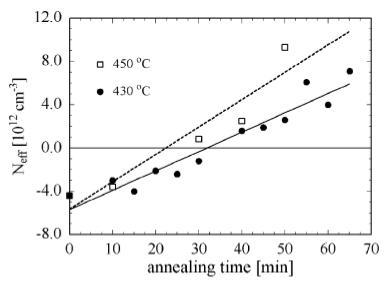E Fretwurst, J Adey, A Al-Ajili, G Alfieri, PP Allport, M Artuso, S Assouak, BS Avset, L Barabash, A Barcz, R Bates, SF Biagi, GM Bilei, D Bisello, A Blue, A Blumenau, V Boisvert, G Bolla, G Bondarenko, E Borchi, L Borrello, D Bortoletto, M Boscardin, L Bosisio, TJV Bowcock, TJ Brodbeck, J Broz, M Bruzzi, A Brzozowski, M Buda, P Buhmann, C Buttar, F Campabadal, D Campbell, A Candelori, G Casse, A Cavallini, S Charron, A Chilingarov, D Chren, V Cindro, P Collins, R Coluccia, D Contarato, J Coutinho, D Creanza, W Cunningham, GF dalla Betta, I Dawson, W de Boer, M de Palma, R Demina, P Dervan, S Dittongo, Z Dolezal, A Dolgolenko, T Eberlein, V Eremin, C Fall, F Fasolo, F Fizzotti, C Fleta, E Focardi, E Forton, E Fretwurst, C Garcia, JE Garcia-Navarro, E Gaubas, MH Genest, KA Gill, K Giolo, M Glaser, C Goessling, V Golovine, SG Sevilla, I Gorelov, J Goss, AG Bates, G Gregoire, P Gregori, E Grigoriev, AA Grillo, A Groza, J Guskov, L Haddad, J Harkonen, F Hauler, M Hoeferkamp, F Honniger, T Horazdovsky, R Horisberger, M Horn, A Houdayer, B Hourahine, G Hughes, I Ilyashenko, K Irmscher, A Ivanov, K Jarasiunas, KMH Johansen, BK Jones, R Jones, C Joram, L Jungermann, E Kalinina, P Kaminski, A Karpenko, A Karpov, V Kazlauskiene, V Kazukauskas, V Khivrich, V Khomenkov, J Kierstead, J Klaiber-Lodewigs, R Klingenberga, P Kodys, Z Kohout, S Korjenevski, M Koski, R Kozlowski, M Kozodaev, G Kramberger, O Krasel, A Kuznetsov, S Kwan, S Lagomarsino, K Lassila-Perini, V Lastovetsky, G Latino, S Lazanu, I Lazanu, A Lebedev, C Lebel, K Leinonen, C Leroy, Z Li, G Lindstrom, V Linhart, A Litovchenko, P Litovchenko, A lo Giudice, M Lozano, Z Luczynski, P Luukka, M Moll, A MacChiolo, LF Makarenko, I Mandic, C Manfredotti, N Manna, S marti I, S Marunko, K Mathieson, J Melone, D Menichelli, A Messineo, J Metcalfe, S Miglio, M Mikuz, J Miyamoto, E Monakhov, F Moscatelli, D Naoumov, E Nossarzewska-Orlowska, J Nysten, P Olivera, V Oshea, T Palvialnen, C Paolini, C Parkes, D Passeri, U Pein, G Pellegrini, L Perera, K Petasecca, C Piemonte, GU Pignatel, N Pinho, I Pintilie, L Pintilie, L Polivtsev, P Polozov, A Popa, J Popule, S Pospisil, A Pozza, V Radicci, JM Rafi, R Rando, R Roeder, T Rohe, S Ronchin, C Rott, A Roy, A Ruzin, HFW Sadrozinski, S Sakalauskas, M Scaringella, L Schiavulli, S Schnetzer, B Schumm, S Sciortino, A Scorzoni, G Segneri, S Seidel, A Seiden, G Sellberg, P Sellin, D Sentenac, I Shipsey, P Sicho, T Sloan, M Solar, S Son, B Sopko, V Sopko, N Spencer, J Stahl, D Stolze, R Stone, J Storasta, N Strokan, M Sudzius, B Surma, A Suvorov, BG Svensson, P Tipton, M Tomasek, A Tsvetkov, E Tuominen, E Tuovinen, T Tuuva, M Tylchin, H Uebersee, J Uher, M Ullan, JV Vaitkus, J Velthuis, E Verbitskaya, V Vrba, G Wagner, I Wilhelm, S Worm, V Wright, R Wunstorf, Y Yiuri, P Zabierowski, A Zaluzhny, M Zavrtanik, M Zen, V Zhukov and N Zorzi
Nuclear Instruments and Methods in Physics Research Section A
552
7–19
2005
The proposed luminosity upgrade of the Large Hadron Collider (S-LHC) at CERN will demand the innermost layers of the vertex detectors to sustain fluences of about 1016 hadrons/cm2. Due to the high multiplicity of tracks, the required spatial resolution and the extremely harsh radiation field new detector concepts and semiconductor materials have to be explored for a possible solution of this challenge. The CERN RD50 collaboration "Development of Radiation Hard Semiconductor Devices for Very High Luminosity Colliders" has started in 2002 an R&D program for the development of detector technologies that will fulfill the requirements of the S-LHC. Different strategies are followed by RD50 to improve the radiation tolerance. These include the development of defect engineered silicon like Czochralski, epitaxial and oxygen-enriched silicon and of other semiconductor materials like SiC and GaN as well as extensive studies of the microscopic defects responsible for the degradation of irradiated sensors. Further, with 3D, Semi-3D and thin devices new detector concepts have been evaluated. These and other recent advancements of the RD50 collaboration are presented and discussed.
 Recent advancements in the development of radiation hard semiconductor detectors for S-LHC
Recent advancements in the development of radiation hard semiconductor detectors for S-LHC